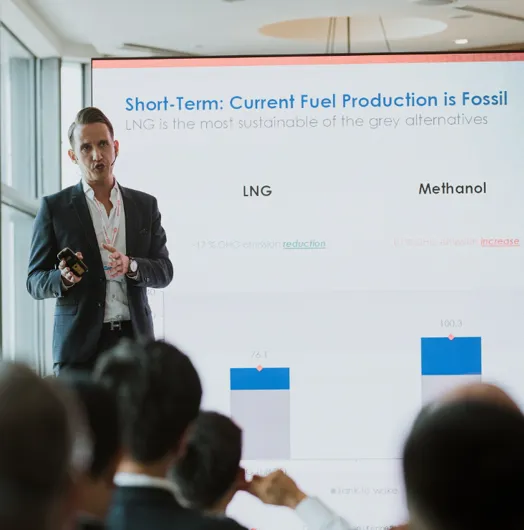2023 regulation will drive lower emissions for the shipping industry
One of the goals set out in the IMO’s 2018 ‘Initial GHG Strategy’ is to reduce the average carbon intensity of the international shipping industry by at least 40% by 2030, relative to 2008. In line with this goal, two new regulatory measures from the IMO, EEXI and CII, came into force from 1st January 2023. The new measures will help to assess, measure, and reduce the CO2 emissions intensity of existing ships.
In July 2023, IMO issued an update to their strategy and targets for the industry to meet. Goals are now centred on total GHG reduction rather than CO2 emission intensity, but EEXI and CII remain valid and significant tools to ensure reduction improvement. Read more on the targets and timelines here.
In 2008, emissions from international shipping peaked at ~1bn tonnes and by 2022 levels had fallen to ~850mt. Over the same period, global seaborne tonne-mile trade increased by ~40%.
Whilst improvements in shipping’s carbon intensity have clearly already been seen, the EEXI and CII regulations will drive further progress, requiring significant energy efficiency improvements in the existing fleet.
In this article we provide a high-level summary of the regulations and their impact.
EEXI
What is EEXI?
Energy Efficiency Existing Ship Index (EEXI).
EEXI comes into effect from 1st January 2023. It is a technical efficiency measure requiring every existing international cargo and passenger vessel of 400 GT and above to reach a target EEXI value by the first renewal of its International Air Pollution Prevention (IAPP) survey. The measure assesses a ship’s CO2 emissions related to its transport capacity.
The calculated attained EEXI value for each individual ship must be below its required EEXI to ensure it meets a minimum energy efficiency standard and is included as part of its IAPP. It is a one-time certification.
IAPP certificates have been utilised since 2009, but the inclusion of the EEXI value is a new requirement from 2023.
How is EEXI calculated?
The EEXI calculation is based on the formula for EEDI (Energy Efficiency Design Index). EEXI measures a ship’s energy efficiency per mile of ship capacity transport work. More specifically, it looks at the installed power of the vessel’s engines, the specific fuel consumption of the engines, a conversion factor between the fuel and corresponding CO2 emissions, the capacity of the ship (generally deadweight) and the ship’s speed at a reference level of installed power.
There are also several ‘correction factors’ that can be applied specific vessel types or to account for structural enhancements that have been made to the ship. The calculation can therefore become quite complex.
Is it possible to improve EEXI ratings?
A vessel can install Engine Power Limitation (EPL), which is a system that limits the maximum power of the ship’s main engine and thus its speed, fuel consumption and CO2 emissions. EPL is one possible solution, though some vessels that require a significant reduction in their EEXI may need to install additional Energy Saving Technologies (ESTs) to reduce fuel consumption.
What happens if a vessel doesn’t meet the EEXI requirements?
All ships are required to have an IAPP, which from 1st January 2023, must include the EEXI value. If ships do not have an EEXI value, then the IAPP can’t be issued. Without a valid IAPP, vessels are unable to trade. If the EEXI value is below the target value, then the ship owner will need to take action to improve the rating.
Who is responsible for calculating and submitting the EEXI rating?
The vessel owner.
How much impact will EEXI have?
Market feedback, and analysis conducted by Clarksons Research, suggests that most ships will be compliant with EEXI following fairly minor modifications (e.g. speed reductions with EPL / some fitting of ESTs), and a small proportion of the fleet is likely to require major modifications (e.g. ESTs with sizeable CAPEX and / or significant speed drops) or have the potential to be non-compliant.
CII
What is CII?
Carbon Intensity Indicator (CII).
CII is an operational efficiency measure applicable to vessels over 5,000 GT from 2023 onwards. It is measured as an annual average of CO2 emissions per mile of ship capacity transport work. An annual rating between A and E is given to the vessel according to whether its CII meets the required level. Required CII is specific to vessel type and size.
Vessels require a ‘C’-rating or better to be compliant. ‘D’ and ‘E’ rated ships will be deemed non-compliant. In this case the vessel owner must then consider improvement plans and include these within its Ship Energy Efficiency Management Plan (SEEMP).
A SEEMP became mandatory in 2013. It establishes a mechanism to improve energy efficiency and performance over time using monitoring tools such as EEOI. Through this, shipowners will have better visibility of the trajectory of their vessel's energy efficiency – it includes everything from energy efficient lightbulbs on board a ship, to the volume of fuel burned.
CII thresholds become increasing more stringent each year to 2026 to drive continuous improvement. A review will be carried out by 1st January 2026 at the latest to understand how the measures are working, and what adjustments might need to be made to ensure the industry aligns with trajectories and targets. CII may also be replaced by other ‘mid-term measures’.
See implementation timeline
How is CII calculated?
CII is calculated based on total annual CO2 emissions divided by the vessel’s capacity (deadweight or GT dependent of ship type) multiplied by the total distance travelled in the year. Some correction factors exist for certain vessel types or voyages. The CII rating will be calculated based on the previous year’s emissions; the first ratings will be calculated in 2024 basis 2023 emissions.
Ship owners are required to initiate the collection of operational data via the IMO Data Collection System (DCS) - this has been the case since 2019. As from April 2024, the annual CII rating must be included within this.
Is it possible to improve CII ratings?
Reducing sailing speed is widely acknowledged as the easiest way to comply with the regulation. Alternatively, retrofitting Energy Saving Technologies (ESTs) can help to improve the CII rating.
There are also operational efficiencies that can be implemented such as optimising sailing routes, reducing waiting times, stronger planning around port congestion and ensuring vessels remain in good condition.
What happens if a vessel does not meet the CII requirements?
Vessels rated as ‘D’ or ‘E’ will have to implement a corrective action plan to show how the required rating of a ‘C’ or above will be achieved. A vessel rated as ‘D’ for three consecutive years or a vessel rated as ‘E’ for one year will have to submit these plans as part of their SEEMP.
From a broader market perspective, CII will be a key performance indicator and may have a direct impact on chartering decisions, values, financing and insurance.
There is also potential for the CII to lead to ‘tiered’ markets, where better rated vessels will achieve a premium from charterers and/or less well-rated vessels trade at a discount.
Who is responsible for calculating and submitting the CII rating?
The vessel owner.
How much impact will CII have on decarbonisation?
Market impact analysis from Clarksons Research suggests that around a third of vessels will be ‘D’ or ‘E’ rated if current operational behaviour continues. This would theoretically rise towards 50% if the fleet composition remained the same in 2026 without modification of speed or specification. Clarksons Research’s theoretical impact assessment scenario suggests that on average a moderate reduction in speed across the fleet would be needed to achieve a ‘C’ rating or above. However, for certain parts of the fleet significant speed reductions could be required. Market impacts from CII, including on speed and market “tiering”, will become more significant over time.
How can Clarksons assist with CII?
CII will have an impact on chartering, S&P and newbuilding activity. For charterers and vessel owners, it is becoming increasingly important to not only understand CII exposure but to then evaluate the various improvement options. Clarksons can help with that, providing bespoke insight to inform better business decisions.
Find out more




